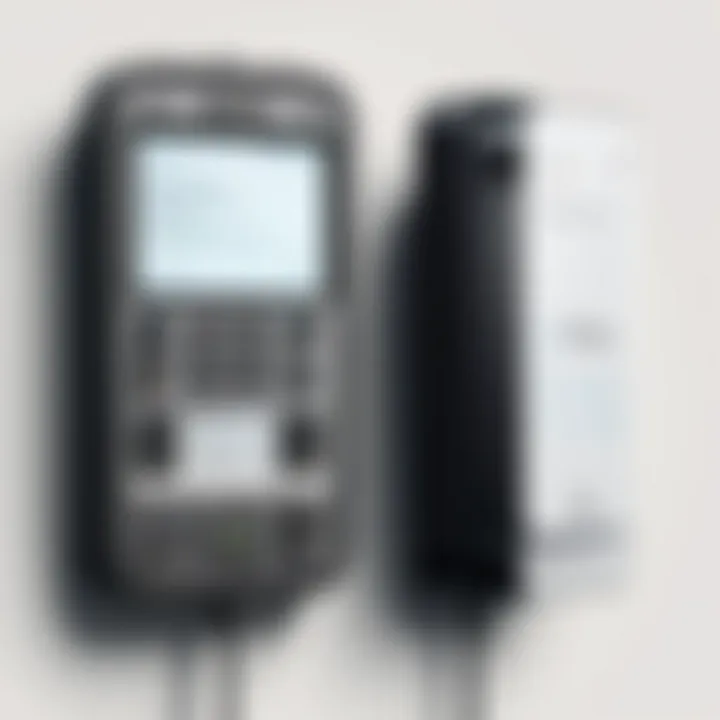Exploring Internet Connectivity Through Phone Lines


Intro
The world of internet connectivity is vast, with many avenues leading to the digital realm. One method that often goes unnoticed is the utilization of traditional phone lines. At first glance, this may seem like an outdated approach, yet the underlying technologies and historical context reveal a rich narrative. Understanding how phone lines work for internet connectivity requires digging into foundational concepts, the evolution of technology, and the current relevance in our hyper-connected age.
In a landscape dominated by fiber optics and wireless connections, it's easy to forget the role that good old telephone lines still play. Especially in remote areas, where high-speed internet options are scant, these lines remain a lifeline. By examining the technical framework that supports this connection, we uncover not just advantages and limitations, but also the potential future pathways for these aging infrastructures.
"In the race for technology, the past often provides the roadmap to the future."
Understanding Networking Concepts
Basics of Networking
Networking revolves around the exchange of information between devices. When considering phone lines for internet access, the focus shifts to Digital Subscriber Line (DSL) technology. DSL modulates signals over standard telephone lines, enabling internet connectivity while allowing voice communication simultaneously.
Key components of networking through phone lines include:
- Modems: Devices that convert digital data to analog signals (and vice versa) to facilitate communication over telephone lines.
- Copper Wiring: The physical medium through which data travels; quality and condition can greatly impact speed and reliability.
- Bandwidth: This term describes the capacity of the network. DSL connections, while slower than fiber optics, can still deliver decent speeds for many users.
Important Terminology
- Asymmetric Digital Subscriber Line (ADSL): A common form of DSL where download speeds are higher than upload speeds.
- Modulation: The process of varying a wave's properties to transmit information. Essential for converting internet data for transmission over phone lines.
- Signal-to-Noise Ratio (SNR): A measure used to quantify the quality of a communication channel. Higher SNR indicates better performance.
Best Practices for Connectivity
Optimizing Phone Line Connections
- Maintaining Copper Lines: Regular inspections and repairs can ensure optimal performance.
- Using Quality Modems: Investing in high-quality, up-to-date modems can significantly enhance connection speeds.
- Minimizing External Interference: Devices that emit electromagnetic interference (like microwaves) should be kept away from phone line setups.
Security Measures
While phone lines may not be as vulnerable to hacking as some wireless networks, it’s still vital to implement security best practices:
- Encryption: Ensures that data transmitted over the phone line is secure from eavesdroppers.
- Firewalls: Set up to monitor and control incoming and outgoing network traffic.
Industry Trends and Updates
- Rollout of Fiber-DSL Hybrid Systems: These systems are emerging that combine the reliability of DSL with the speed of fiber optics.
- Potential for Future Technologies: As technology progresses, advancements in phone line infrastructure may unlock faster internet speeds.
Finale
In revisiting the capability of phone lines for internet connectivity, it’s evident that they still hold value, especially in certain geographical contexts. By grasping the details of networking terminology and applying best practices, users can navigate challenges and harness the power of this sometimes-overlooked technology. Envisioning the future also invites exploration into how these traditional methods can evolve alongside new advancements, making connectivity accessible to more people in diverse environments.
Historical Context of Internet Access
Understanding the historical context of internet access offers an essential backdrop for grasping today's digital environment. It sheds light on how traditional methods, like utilizing phone lines, have significantly influenced the development of internet technologies. In a world where high-speed broadband is the norm, recalling the humble beginnings of internet access via dial-up services reveals the stark contrasts and improvements since then. Studying this evolution helps professionals appreciate the technical innovations we often take for granted today.
Origin of Dial-Up Internet
The origin of dial-up internet traces back to the late 1960s. Initially created for academic and government use, ARPANET, which was a precursor to the internet, relied on a network of dedicated lines. But it wasn’t until the late 1980s that dial-up internet became a household term. Services like America Online (AOL) and CompuServe enabled average Americans to connect to the internet through the existing telephone infrastructure. Users would pick up the phone, dial a number, and listen as their modem created a symphony of beeps and tones, establishing a connection. Though slow by today's standards, this was revolutionary at the time and democratized access to information.
Evolution of Communication Technologies
As communication technologies evolved, the landscape of internet access transformed remarkably. By the mid-1990s, the introduction of more sophisticated modems and the burgeoning World Wide Web paved the way for broader adoption of dial-up services. Technologies like ISDN and DSL emerged, promising faster speeds over standard copper telephone lines. Each iteration showcased improvement in data transfer rates and user experience. It's intriguing to see how telecommunication companies continuously upgraded infrastructure, eventually leading to the contemporary digital frameworks we utilize. Options such as fiber optics began to emerge, creating a rift in the traditional reliance on phone lines for internet access.
Transition from Analog to Digital
The transition from analog to digital communications marked a pivotal moment in the history of internet connectivity through phone lines. Initially, analog signals dominated the communication landscape. However, as technology progressed, digital transmission became the preferred method due to its efficiency and superior quality. The rise of digital modems allowed for faster data encoding and transmission. Digital signals could carry more information and with less noise, vastly improving the user experience. This shift wasn’t merely technological, it represented a cultural move towards a more connected and efficient society where information exchanged at previously unimagined speeds. Essential for anyone in IT or cybersecurity, this transition fueled the need for robust security measures and better protocols to protect the ever-growing user data.
"The shift from analog to digital not only changed how information was transmitted but also redefined the entire spectrum of communication technologies."


Technical Mechanisms of Phone Line Internet
Understanding how internet connectivity through phone lines operates is critical, especially as we reflect on the earlier eras of internet access. While often seen as a somewhat outdated technology compared to fiber optics or cable, the mechanisms involved still hold relevance today. Deciphering these elements not only reveals how dial-up connections function but also sheds light on the evolution of digital communication and the implications for various demographics still utilizing this method.
Understanding the Phone Line Infrastructure
At the heart of phone line internet connectivity lies the Public Switched Telephone Network (PSTN). This network was initially designed for voice communication, allowing callers to connect through a series of switches over copper wires. For internet access, phone lines operate much the same way. When a user dials into an Internet Service Provider (ISP), the modem translates digital signals into analog ones, passing through these lines.
The primary infrastructure involves:
- Copper Wires: These are the physical foundation, typically found in homes and businesses, delivering a basic connection.
- Telephone Exchanges: Points where calls are routed, these exchanges also manage dial-up connections.
- Modems: Devices that serve as the bridge between computers and the telephone lines.
Understanding this structure emphasizes the longevity and inevitability of certain technological limitations inherent in these lines.
How Dial-Up Modems Function
Dial-up modems play a pivotal role in connecting computers to the internet via phone lines. They convert digital data from a user’s device into analog signals that can traverse the PSTN. Once the analog signal reaches the ISP, it is reverted back into digital format, allowing communication.
Here’s a simplified look at the process:
- Connection Initiation: When users engage the modem, it emits a dialing signal through the phone line to reach the ISP.
- Authentication: Upon connecting, the modem and ISP verify the user's account, paving the way for data exchange.
- Data Transmission: The modem then sends and receives data in a continuous loop, switching between digital and analog formats.
Modems can often connect at rates of 56 kbps, a significant limitation compared to current broadband speeds.
Signal Transmission and Data Encoding
The encoding of signals is a specialized process that ensures data integrity while being sent over phone lines. Typically, modems utilize Frequency Shift Keying (FSK) or Phase Shift Keying (PSK) to impart data with various frequencies representing different bits of information.
This method possesses several advantages:
- Error Correction: It allows for simple corrections of corruption in data, ensuring a cleaner signal.
- Simplicity: The techniques involved in encoding are less complex and can be more easily implemented than those used in modern broadband technologies.
However, signal quality can be impacted by noise and attenuation over distance, causing further constraints on performance.
Comparative Analysis with Broadband Technologies
When juxtaposing phone line internet technology with modern broadband systems, clear disparities arise. Broadband typically signifies always-on connections achieved through various mediums such as DSL and fiber optic technology, boasting faster data rates and improved reliability.
Key differences include:
- Speed: While dial-up limits speeds to about 56 kbps, broadband can soar into the realm of megabits, radically changing user experience.
- Connection Stability: Always-on broadband connections reduce the chance of disconnection, which is commonplace in dial-up setups.
- Data Capacity: Broadband technologies usually support much higher data transfer rates, making them suitable for streaming and other data-heavy tasks.
Despite these differences, phone lines continue to serve a unique segment of users, particularly in areas where broadband infrastructure remains scarce or prohibitively expensive.
"Dial-up internet may be a relic of the past for many, but it remains an accessible entry point for users in underserved regions."
Understanding these technical mechanisms allows for a fuller appreciation of past innovations in internet technology and how they continue to influence our digital landscape today.
Advantages of Internet through Phone Lines
The utilization of traditional phone lines for internet access offers some distinct advantages, especially in contexts where newer technologies may not be as accessible or practical. This section explores the compelling aspects of using phone lines for internet connectivity, focusing particularly on its significance in enhancing accessibility and minimizing costs tied to infrastructure. As we dissect these benefits, we aim to illuminate how these factors contribute to the overall relevance of dial-up connections in our increasingly digital landscape.
Accessibility in Rural Areas
One of the leading advantages of accessing the internet via phone lines is the ability to reach rural areas where high-speed broadband services may lag behind. Many remote communities remain in the digital dark, grappling with limited options for connectivity. Here, traditional phone lines can fill a vital gap.
- Widespread Availability: Unlike fiber or cable broadband that depends heavily on infrastructure, phone lines are often already in place in many rural locales. Even in places where newer services have yet to materialize, chances are, the basic framework for dial-up is intact, offering a form of access that can be life-changing.
- Affordability: For regions burdened by economic constraints, the simplicity and lower setup costs associated with phone line internet can be a game-changer. Residents don’t need to invest in expensive hardware or comprehensive network installations.
- Fostering Opportunities: The internet access that phone lines provide can open new doors for education and entrepreneurship. A student in a rural area can access online resources; a budding entrepreneur can launch a small business remotely without breaking the bank for connectivity.
Accessing the internet in these under-served areas can also strengthen community ties and facilitate communication, bridging the gap between urban and rural populations.
Lower Infrastructure Costs


Another key advantage of using phone lines for internet connectivity lies in the cost savings associated with infrastructure. Here’s how dial-up delivers affordability:
- Minimal Investment: Setting up a dial-up connection requires far less investment compared to broadband alternatives that may demand significant upgrades to existing systems. For instance, local service providers can often repurpose existing phone line infrastructure rather than having to lay new cables or install fiber-optic lines.
- Reduced Maintenance Fees: Once a dial-up system is up and running, the ongoing maintenance costs tend to be lower. The equipment used—for example, a standard modem—typically costs much less to replace than more complex systems associated with broadband technology.
- Flexible Pricing Models: Many ISPs offer pricing options that can cater to different demographics. Clients looking for basic internet service can often choose a plan that suits their needs without burning a hole in their pockets.
In summary, the accessibility provided by internet through phone lines, particularly in rural areas, coupled with the cost benefits, foster a digital environment that contrasts sharply with the barriers imposed by modern technologies.
Limitations of Phone Line Connectivity
When considering the methods through which the internet can be accessed, particularly in areas with restricted options, it’s imperative to discuss the limitations of connectivity via phone lines. While traditional telephone networks have served as a significant gateway into the digital realm for many users over the years, they carry with them a set of constraints that can hinder the overall experience and performance of internet access. Understanding these limitations can help users gauge whether this connection method meets their needs or if exploring alternative options is warranted.
Bandwidth Constraints
In terms of bandwidth, phone line internet using dial-up modems tends to lag way behind more modern internet services. Generally, connections through phone lines offer speeds ranging from 28.8 Kbps to 56 Kbps, which seem almost laughable compared to today’s fiber-optic and even basic broadband technologies. With increasing numbers of video streaming services and heavy-data applications, these speeds can quickly become bottlenecks.
- It’s like trying to sip a smoothie through a coffee stirrer; you can get some of the goodness but not nearly enough to satisfy modern cravings.
- Adding multiple devices or users vying for the same speed is a recipe for frustration. Each additional connection divides the bandwidth, resulting in painfully slow performance.
To make matters worse, distances from central offices can significantly impact attainable speeds. The further you are from your service provider’s infrastructure, the muddier the waters become.
Latency Issues
Another pressing limitation derived from using phone lines for internet is latency – the delay before data begins transferring across the connection. Dial-up connections are notorious for their high latency compared to broadband alternatives. This can manifest in various unpleasant ways:
- Loading Times: The dreaded buffering wheel becomes all too familiar when waiting for web pages or videos to load.
- Real-Time Applications: Activities like video calls or online gaming can be tortured experiences due to the lag, leaving participants feeling disconnected.
In essence, latency with dial-up can turn the internet into a clunky pastiche of the fluid experience users crave today. As real-time engagement surges in importance, such as telecommuting and live-streaming events, high latency can serve as a substantial roadblock.
Dependence on Legacy Systems
Lastly, there’s the issue of dependence on aging infrastructure, a rather critical element when discussing phone line internet. Many phone networks are remnants of earlier technological eras, designed when the internet was still in its infancy. As a result, these systems often exhibit several limitations that impede performance:
- Older copper lines can be susceptible to interference, leading to dropped connections or subpar quality.
- The technology used to transmit data over these lines is infrequently updated, leaving users stranded with outdated equipment and protocols.
A vast number of users are still operating on systems built for the past rather than optimized for modern-day demands. It’s worth pondering—how can a legacy system keep pace with the rapid evolution of the internet? Although some companies attempt to maintain and upgrade these systems, it often represents only a patchwork solution rather than a comprehensive answer to the challenges ahead.
"Sticking with outdated systems might be like wearing bell-bottoms, appealing to nostalgia but not quite fitting the modern climate."
In summary, while there are undeniable benefits to using phone lines for internet access, it becomes increasingly clear that the limitations impact user experience significantly. Bandwidth constraints, latency issues, and reliance on legacy systems create a myriad of challenges. Navigating these waters requires a keen understanding of what users can realistically expect when choosing this connection method.
The Role of Dial-Up in Current Internet Landscape
The world of internet connectivity has gone through a whirlwind of changes since the inception of dial-up technology. Even as we stand amidst the high-speed wonders of fiber optics and 5G networks, dial-up still carves out a niche, serving purposes that might not be readily visible at first glance. Dial-up’s role in today’s internet fabric is multifaceted; it’s more than just a relic of the past or a symbol of nostalgia.
Relevance of Dial-Up Services Today
Despite the apparent limitations, dial-up services hold significance in various contexts. One primary aspect is accessibility. In rural or remote regions, where advanced infrastructure may be lacking, dial-up remains a reliable option. For individuals or communities with scarce resources, the cost savings regarding installation can make a dial-up connection far more appealing than other alternatives. This sustained utility stands in stark contrast to the notion that dial-up is entirely obsolete.
Moreover, dial-up connections provide unique benefits that aren’t immediately obvious. For those who engage primarily in lighter online activities such as reading emails or browsing static websites, the available bandwidth—although limited—suffices. It's akin to using a bicycle for a short commute while others might fly by in their cars. Especially in the context of budget constraints, dial-up can be a lifeline, allowing users to remain connected without spiraling costs.
Additionally, the simplicity and reliability of dial-up equipment can be appealing. Lower chances of complex malfunction or the need for high-end routers mean less operational fuss. In areas where technology might be intimidating or sparse, dial-up can serve as an anchor, lending a semblance of stability to internet access.
"Dial-up connects the disconnected, proving even in a world racing towards faster speeds, slowness can still hold value."
Target Demographics for Dial-Up
Target demographics for dial-up services are diverse and often underappreciated. A core group includes elderly users or those wary of technology. For some seniors who grew comfortable with 56k modems, switching to broadband may feel akin to uprooting them from their established way of life. These users prefer sticking to dial-up for its ease of use and straightforward nature.
Another demographic includes students and low-income families, who, despite the digital divide, require access to educational resources. For these groups, a dial-up connection may be sufficient for basic research or email communication, promoting continuity in education.
Lastly, small business owners in economically constrained areas often leverage dial-up as a cost-effective method to maintain customer communications or to access internet services necessary for business operations. Again, it's no frills, just functional.
In essence, while dial-up may seem like yesterday’s news, it remains a lifeline for many, meeting specific needs that more modern solutions cannot.


As we look ahead, understanding the role of dial-up within the current internet landscape allows us to appreciate the broader context of connectivity. Existing side by side with newer technologies, dial-up isn't merely an afterthought—it embodies a uniquely persistent component of the digital age.
Future Prospects of Phone Line Internet Access
The landscape of internet connectivity is always shifting. While many might focus on cutting-edge fiber optics or satellite internet, the legacy of phone line connectivity should not be overlooked. The potential for future developments in this domain could offer unique solutions, especially for regions where newer technologies have yet to take root. Understanding the future of phone line internet access provides a lens through which we can view challenges and innovations in digital connectivity today.
Technological Innovations on the Horizon
Currently, a number of emerging technologies could reinvigorate the use of phone line-based internet connections. For instance, advancements in DSL technology continue to provide faster speeds on existing copper lines. By leveraging VDSL2 (Very-high-bit-rate Digital Subscriber Line 2) and other variations, phone lines can offer speeds up to 100 Mbps in certain conditions. While that may not compete with fiber optics, it's a significant upgrade for many users.
Another innovation is the potential for hybrid networks. By integrating traditional phone lines with wireless solutions, users could experience seamless transitions between different connectivity methods. Such frameworks could support users in rural areas where extending high-speed internet via fiber is economically unfeasible.
Integration with Modern Digital Frameworks
Phone line internet access is increasingly being woven into the fabric of modern digital communication. As Internet of Things (IoT) devices proliferate, a smart home can rely on connectivity methods beyond just Wi-Fi. In contexts where newer technologies are unavailable, classic phone lines can still support basic internet access for IoT devices, allowing for smart devices to communicate without requiring extensive infrastructure overhaul.
Moreover, project experiments focusing on combining various legacy systems with contemporary software solutions show promise. For instance, network virtualization techniques applied to traditional phone lines could help optimize their performance, improving user experience without extensive hardware upgrades. In areas still heavily reliant on analog systems, this blend of old and new could ensure robust service without a massive overhaul.
The Endurance of Legacy Technologies
Though one might assume that technological progress inevitably eclipses the old, legacy technologies have a surprising persistence. Many users remain tethered to phone line-based internet due to geographical constraints or simply comfort with existing systems. Furthermore, the low cost of maintaining such infrastructures makes them a preferred option in specific contexts.
The endurance of these technologies can also be seen in the resilience of dial-up connections. While their number is dwindling, they still serve niche audiences. For some elderly users or individuals in remote locations, dial-up offers a necessary link to the online world without needing to upgrade devices or endure complex setups.
"In certain areas, the old phone lines are still the lifelines for communities, demonstrating that technology's legacy can coexist with modern advancements."
This resilience suggests that phone line connectivity is far from dead; rather, it has the potential for revival with strategic improvements and integrations.
Ultimately, the future of phone line internet access lies in the delicate balance between innovation and tradition. Recognizing the potential for modern technological integration while respecting its historical roots could lead to unexpected advancements and solutions in the quest for global connectivity.
Implications for Cybersecurity
When discussing Internet connectivity through phone lines, it’s crucial to examine the implications for cybersecurity. Unlike more modern protocols, dial-up connections often present unique vulnerabilities due to their legacy nature. While the use of traditional phone lines for internet access provides certain advantages, such as accessibility in remote areas, this mode of connection can also be a double-edged sword in terms of security.
Risks Associated with Dial-Up Connections
Dial-up internet access has risks that stem from its outdated technology and the specific nature of its operation. Some notable risks include:
- Exposure to Sneaky Attacks: Dial-up systems often employ outdated authentication methods, making them susceptible to interception by malicious actors. This weakness could be seen as an open invitation for hackers.
- Limited Encryption: Unlike contemporary broadband connections, many dial-up services do not utilize robust encryption protocols. Data transferred over these lines may be vulnerable to eavesdropping.
- Inherent Connection Interceptions: Since dial-up involves a direct connection via phone lines, the possibility of wiretapping exists, potentially compromising shared communications.
- Dependency on Shared Lines: When multiple users share a phone line for internet access, there’s an increased risk that sensitive information could be accessed by others connected to the same service.
These factors together create a security landscape that is fraught with potential issues, making vigilance and proactive measures essential for users relying on dial-up connections.
Protective Measures for Dial-Up Utilization
To mitigate the risks associated with dial-up connections, users need to adopt a range of protective measures. Some effective strategies include:
- Utilize VPN Services: A Virtual Private Network adds another layer of security by encrypting internet traffic. This can help protect data from prying eyes.
- Enable Firewall Protections: Software and hardware firewalls can fend off unauthorized access attempts, acting as a barrier between the internet and your system.
- Regular Software Updates: Keeping communication software and antivirus programs up-to-date helps patch vulnerabilities that hackers may exploit.
- Implement Strong Passwords: Using robust, unique passwords for online accounts makes it harder for malicious users to gain unauthorized entry.
- Monitor Connection Activity: Keeping an eye on connection logs helps users notice unusual activity, enabling quick responses to potential threats.
"In a world where every click can have repercussions, taking cybersecurity seriously on legacy systems is not just recommended, it is essential."
By instilling these practices and remaining aware of the inherent risks, users can enhance their security while utilizing dial-up internet through phone lines. Engagement with these safeguards can significantly reduce the likelihood of falling prey to cyber threats, allowing individuals to navigate the digital landscape more securely.
End
Summarizing Key Insights
Through this article, we uncovered a wealth of information regarding how phone lines have historically enabled internet access. Here are the vital takeaways:
- Historical Significance: Phone lines were foundational in establishing the first connections to the internet. Their evolution mirrors advancements in technology and society's growing dependence on online resources.
- Technical Mechanics: Understanding the mechanics behind dial-up modems and their infrastructure is essential. It helps clarify how data is transmitted over these legacy systems, which though dated, are still in use in various settings.
- Advantages vs. Limitations: While accessibility in rural regions and lower costs are benefits, limitations such as bandwidth constraints and latency issues are significant challenges that cannot be ignored.
- Cybersecurity Implications: Dial-up connections pose unique risks, requiring specialized protective measures for secure usage.
Ultimately, these points illustrate the enduring legacy of phone line connectivity in an increasingly digital world.
Final Thoughts on Future Connectivity
Looking ahead, the landscape of internet connectivity will continue to evolve. Though many may deem phone lines as archaic, innovations suggest they could still play a role, especially in areas lacking advanced infrastructure. Here are some considerations:
- Technological Innovations: Emerging technologies may integrate with legacy systems, allowing for enhanced functionality without completely overhauling existing infrastructure.
- Community Connectivity: In remote areas or low-income regions, leveraging phone lines can ensure that no one is left behind as digital resources become more critical.
- Sustainability of Legacy Systems: Dial-up methods may persist, serving a specialized purpose even as the majority of internet users shift to faster, more efficient broadband services.



